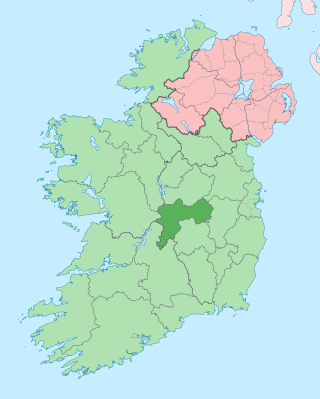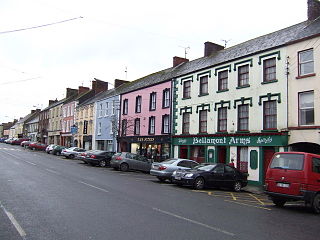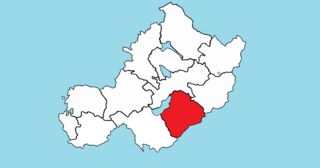
County Offaly is a county in Ireland. It is part of the Eastern and Midland Region and the province of Leinster. It is named after the ancient Kingdom of Uí Failghe. It was formerly known as King's County, in honour of Philip II of Spain. Offaly County Council is the local authority for the county. The county population was 82,668 at the 2022 census.

Birr is a town in County Offaly, Ireland. Between 1620 and 1899 it was called Parsonstown, after the Parsons family who were local landowners and hereditary Earls of Rosse. The town is in a civil parish of the same name.

Birr Castle is a large castle in the town of Birr in County Offaly, Ireland. It is the home of the 7th Earl of Rosse and his family, and as the castle is generally not open to the public, though the grounds and gardens of the demesne are publicly accessible, and include a science museum and a café, a reflecting telescope which was the largest in the world for decades and a modern radio telescope.

Banagher is a town in Ireland, located in the midlands, on the western edge of County Offaly in the province of Leinster, on the banks of the River Shannon. The town had a population of 3,000 at the height of its economic growth in the mid-19th century. According to the 2022 census, its population was 1,907.
Sir Edward Lovett Pearce was an Irish architect, and the chief exponent of Palladianism in Ireland. He is thought to have initially studied as an architect under his father's first cousin, Sir John Vanbrugh. He is best known for the Irish Houses of Parliament in Dublin, and his work on Castletown House. The architectural concepts he employed on both civic and private buildings were to change the face of architecture in Ireland. He could be described as the father of Irish Palladian architecture and Georgian Dublin.
The architecture of Ireland is one of the most visible features in the Irish countryside – with remains from all eras since the Stone Age abounding. Ireland is famous for its ruined and intact Norman and Anglo-Irish castles, small whitewashed thatched cottages and Georgian urban buildings. What are unaccountably somewhat less famous are the still complete Palladian and Rococo country houses which can be favourably compared to anything similar in northern Europe, and the country's many Gothic and neo-Gothic cathedrals and buildings.

Cootehill is a market town and townland in County Cavan, Ireland. Cootehill was formerly part of the neighbouring townland of Munnilly. Both townlands lie within the barony of Tullygarvey. Cootehill is 20 km north-east of Cavan town and 20 km south-west of Monaghan town. As of the 2022 census, the population was 1,856.

Ballyhaise is a village in County Cavan, Ireland. It is situated approximately 7 km (4.3 mi) north-northeast of Cavan and 11 km, via the N54, from the border with County Fermanagh in Northern Ireland. The River Annalee flows near the village. As of 2022, the village had a population of 748.

Riverstown is a small village straddling the border between Counties Tipperary and Offaly on the outskirts of Birr in Ireland. It is mostly within the townland of Ballyloughnane, on the Tipperary side of the river.

Shinrone is a village in County Offaly, Ireland. It is in the southernmost part of the county, situated very close to the border with County Tipperary. It lies at the junction of the R491 regional road between Nenagh and Roscrea with the R492 to Sharavogue. At the 2016 census, the village population was 645. The village is in a townland and civil parish of the same name.

Brosna is a small village and townland in County Offaly, Ireland. 7 km north-west of Roscrea, it lies in the valley of the Little Brosna River near the N62 road. The area takes its name from the Little Brosna River, which flows along the north-eastern edge of the townland. As of the 2011 census, Brosna townland had a population of 31 people.
Coolderry is a small roadside village in southern County Offaly, Ireland. It is located 8 kilometres north of Roscrea and 11 kilometres south of Birr. The village lies close to the Slieve Bloom Mountains.

The Little Brosna River rises near Dunkerrin, County Offaly, Ireland. It flows for 36 miles before joining the River Shannon.
Derrinsallow is a townland in the historical Barony of Ormond Lower, County Tipperary, Ireland. It is located North-West of Birr on the south-west bank of the Little Brosna River within the civil parish of Dorrha. The Little Brosna River provided power to the 19th century corn mills at Derrinsallow which although now in ruins are mentioned in the National Inventory of Architectural Heritage. The mill race is a popular fishing area. A triple arched limestone bridge from the 19th century crosses the river here.

Summerhill House was a 100-roomed Palladian house in County Meath, Ireland which was the ancestral seat of the Viscounts Langford and the Barons Langford. Built in 1731, it was likely designed by Sir Edward Lovett Pearce and completed by Richard Cassels in the Palladian style, although Sir John Vanbrugh, who was related to Pearce and with whom he trained, is thought to have also influenced the design of the house, which could be seen by the Baroque details, great arched chimney stacks and the palatial grandeur and scale.
Sharavogue is a townland in the historical Barony of Clonlisk, County Offaly, Ireland. It is a rural area located near the junction of the N52 road and the R492 between Roscrea and Birr. The Little Brosna River flows under Sharavogue bridge.

Clonlonan is a barony in south–west County Westmeath, Ireland. It was formed by 1672. It is bordered by County Offaly to the south and a small part of County Roscommon at Long Island on the River Shannon to the west. It also borders four other Westmeath baronies: Kilkenny West and Rathconrath, Moycashel and Brawny. The largest centre of population in the barony is the town of Moate.

Fartullagh, previously Tyrrells country, is a barony in south–east County Westmeath, in Ireland. It was formed by 1542. It is bordered by County Offaly to the south and three other baronies: Moycashel, Moyashel and Magheradernon and Farbill.

Desart Court was a house in County Kilkenny, Ireland, built around 1733 for the first Lord Desart, John Cuffe. The architect is believed to have been Sir Edward Lovett Pearce.

The Printing House is a classical Palladian style temple building that was constructed within the campus of Trinity College Dublin around 1734 under the tenure of provost Richard Baldwin.
















